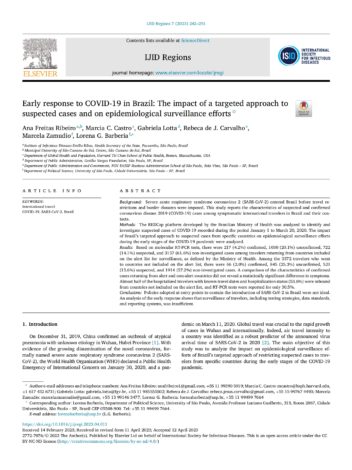Abstract
Background: Severe acute respiratory syndrome coronavirus 2 (SARS-CoV-2) entered Brazil before travel restrictions and border closures were imposed. This study reports the characteristics of suspected and confirmed coronavirus disease 2019 (COVID-19) cases among symptomatic international travelers in Brazil and their contacts.
Methods: The REDCap platform developed by the Brazilian Ministry of Health was analyzed to identify and investigate suspected cases of COVID-19 recorded during the period January 1 to March 20, 2020. The impactof Brazil’s targeted approach to suspected cases from specific countries on epidemiological surveillance efforts during the early stages of the COVID-19 pandemic were analyzed.
Results: Based on molecular RT-PCR tests, there were 217 (4.2%) confirmed, 1030 (20.1%) unconfirmed, 722 (14.1%) suspected, and 3157 (61.6%) non-investigated cases among travelers returning from countries included on the alert list for surveillance, as defined by the Ministry of Health. Among the 3372 travelers who went to countries not included on the alert list, there were 66 (2.0%) confirmed, 845 (25.3%) unconfirmed, 521 (15.6%) suspected, and 1914 (57.2%) non-investigated cases. A comparison of the characteristics of confirmed cases returning from alert and non-alert countries did not reveal a statistically significant difference in symptoms. Almost half of the hospitalized travelers with known travel dates and hospitalization status (53.6%) were inbound from countries not included on the alert list, and RT-PCR tests were reported for only 30.5%.
Conclusions: Policies adopted at entry points to contain the introduction of SARS-CoV-2 in Brazil were not ideal. An analysis of the early response shows that surveillance of travelers, including testing strategies, data standards, and reporting systems, was insufficient.


